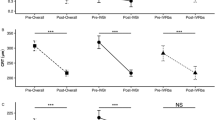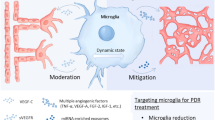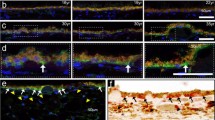Abstract
Purpose
To determine the molecular mechanisms underlying ocular ischemic syndrome (OIS). This study uses a rat model to evaluate the role of the RhoA/MEK1/ ERK1/2/iNOS pathways in response to OIS-associated oxidative and nitrosative stress, with a long-term goal of identifying therapeutic targets for OIS.
Methods
Rats were randomly allocated to one of three groups: bilateral occlusion of the common carotid artery (BOCCA), sham surgery control, or unoperated control (n = 8/group). Three months after the procedure, retinas were analyzed anatomically, using immunohistochemistry and by enzyme-linked immunosorbent assay for RhoA, MEK1, ERK1, ERK2, iNOS. Retinal injury was assessed using TUNEL. Levels of superoxide dismutase (SOD) and malondialdehyde (MDA) were measured by WST-1 and TBA methods, respectively.
Results
In BOCCA rats, occlusion of the bilateral common carotid artery induced degeneration of retinal ganglion cells, which was not observed in either control group. Retinal levels of RhoA, MEK1, ERK1, ERK2, iNOS, NOX2, and MDA were elevated in the BOCCA group, but not in either control group. In comparison, retinal levels of SOD were reduced in SOD animals. By immunofluorescent staining, RhoA was elevated in all retinal layers, while the increased levels of MEK, ERK1/1, and NOX were restricted to the INL, and that of ERK1/2 and NOX inner nuclear layer; iNOS elevations were observed in both the inner and outer nuclear layers. TUNEL labeling results showed that BOCCA group is higher staining than sham and control group.
Conclusions
OIS elevates activity of the RhoA/MERK1/ERK1/2/iNOS pathways throughout the retina, likely reflecting a response to oxidative and nitrosative stress. Retinal thickness was reduced in BOCCA rats, reflecting a loss of retinal ganglion cells following the reduced blood flow to the eye. These results indicate that drugs that inhibit these pathways may be effective treatments for OIS.








Similar content being viewed by others
References
Terelak-Borys B, Skonieczna K, Grabska-Liberek I (2012) Ocular ischemic syndrome - a systematic review. Med Sci Monit 18:RA138–144
Lavinsky D, Arterni NS, Achaval M, Netto CA (2006) Chronic bilateral common carotid artery occlusion: a model for ocular ischemic syndrome in the rat. Graefes Arch Clin Exp Ophthalmol 244:199–204
Jaffe AB, Hall A (2005) Rho GTPases: biochemistry and biology. Annu Rev Cell Dev Biol 21:247–69
Heasman SJ, Ridley AJ (2008) Mammalian Rho GTPases: new insights into their functions from in vivo studies. Nat Rev Mol Cell Biol 9:690–701
Chi X, Wang S, Huang Y et al (2013) Roles of rho GTPases in intracellular transport and cellular transformation. Int J Mol Sci 14:7089–108
Amano M, Fukata Y, Kaibuchi K (2000) Regulation and functions of Rho-associated kinase. Exp Cell Res 261:44–51
Olson MF (2004) Contraction reaction: mechanical regulation of Rho GTPase. Trends Cell Biol 14:111–4
Ong TJ, Paine M, O’Day J (2002) Retinal manifestations of ophthalmic artery hypoperfusion. Clin Experiment Ophthalmol 30:284–91
Schofield AV, Bernard O (2013) Rho-associated coiled-coil kinase (ROCK) signaling and disease. Crit Rev Biochem Mol Biol 48:301–16
Noma K, Kihara Y, Higashi Y (2012) Striking crosstalk of ROCK signaling with endothelial function. J Cardiol 60:1–6
Satoh K, Fukumoto Y, Shimokawa H (2011) Rho-kinase: important new therapeutic target in cardiovascular diseases. Am J Physiol Heart Circ Physiol 301:H287–96
Dumont AS, Dumont RJ, Chow MM et al (2003) Cerebral vasospasm after subarachnoid hemorrhage: putative role of inflammation. Neurosurgery 53:123–33, discussion 133–5
Kaminska B (2005) MAPK signalling pathways as molecular targets for anti-inflammatory therapy--from molecular mechanisms to therapeutic benefits. Biochim Biophys Acta 1754:253–62
Katada K, Bihari A, Badhwar A et al (2009) Hindlimb ischemia/reperfusion-induced remote injury to the small intestine: role of inducible nitric-oxide synthase-derived nitric oxide. J Pharmacol Exp Ther 329:919–27
Kuntscher MV, Kastell T, Altmann J et al (2002) Acute remote ischemic preconditioning II: the role of nitric oxide. Microsurgery 22:227–31
Li G, Labruto F, Sirsjo A et al (2004) Myocardial protection by remote preconditioning: the role of nuclear factor kappa-B p105 and inducible nitric oxide synthase. Eur J Cardiothorac Surg 26:968–73
Sari AN, Kacan M, Unsal D et al (2014) Contribution of RhoA/Rho-kinase/MEK1/ERK1/2/iNOS pathway to ischemia/reperfusion-induced oxidative/nitrosative stress and inflammation leading to distant and target organ injury in rats. Eur J Pharmacol 723:234–245. doi:10.1016/j.ejphar.2013.11.027
Song H, Gao D (2011) Fasudil, a Rho-associated protein kinase inhibitor, attenuates retinal ischemia and reperfusion injury in rats. Int J Mol Med 28:193–198. doi:10.3892/ijmm.2011.659
Mitchell DC, Bryan BA, Liu JP et al (2007) Developmental expression of three small GTPases in the mouse eye. Mol Vis 13:1144–53
Chun J, Choi RJ, Khan S et al (2012) Alantolactone suppresses inducible nitric oxide synthase and cyclooxygenase-2 expression by down-regulating NF-kappaB, MAPK and AP-1 via the MyD88 signaling pathway in LPS-activated RAW 264.7 cells. Int Immunopharmacol 14:375–83
Park JY, Pillinger MH, Abramson SB (2006) Prostaglandin E2 synthesis and secretion: the role of PGE2 synthases. Clin Immunol 119:229–40
Kim SF, Huri DA, Snyder SH (2005) Inducible nitric oxide synthase binds, S-nitrosylates, and activates cyclooxygenase-2. Science 310:1966–70
Li XN, Su J, Zhao L et al (2013) The p38 MAPK inhibitor JLU1124 inhibits the inflammatory response induced by lipopolysaccharide through the MAPK-NF-kappaB pathway in RAW264.7 macrophages. Int Immunopharmacol 17:785–92
Shi Q, Cao J, Fang L et al (2014) Geniposide suppresses LPS-induced nitric oxide, PGE2 and inflammatory cytokine by downregulating NF-kappaB, MAPK and AP-1 signaling pathways in macrophages. Int Immunopharmacol 20:298–306
Kim KN, Ko YJ, Yang HM et al (2013) Anti-inflammatory effect of essential oil and its constituents from fingered citron (Citrus medica L. var. sarcodactylis) through blocking JNK, ERK and NF-kappaB signaling pathways in LPS-activated RAW 264.7 cells. Food Chem Toxicol 57:126–31
Folino A, Losano G, Rastaldo R (2013) Balance of nitric oxide and reactive oxygen species in myocardial reperfusion injury and protection. J Cardiovasc Pharmacol 62:567–75
Sebastian S, Settleman J, Reshkin SJ et al (2006) The complexity of targeting EGFR signalling in cancer: from expression to turnover. Biochim Biophys Acta 1766:120–39
Guo XJ, Tian XS, Ruan Z et al (2014) Dysregulation of neurotrophic and inflammatory systems accompanied by decreased CREB signaling in ischemic rat retina. Exp Eye Res 125:156–163. doi:10.1016/j.exer.2014.06.003
Fang I-M, Yang C-M, Yang C-H (2015) Chitosan oligosaccharides prevented retinal ischemia and reperfusion injury via reduced oxidative stress and inflammation in rats. Exp Eye Res 130:38–50. doi:10.1016/j.exer.2014.12.001
Han J, Shuvaev VV, Muzykantov VR (2012) Targeted interception of signaling reactive oxygen species in the vascular endothelium. Ther Deliv 3:263–76
Wheeler LA, Gil DW, WoldeMussie E (2001) Role of alpha-2 adrenergic receptors in neuroprotection and glaucoma. Surv Ophthalmol 45(Suppl 3):S290–294, discussion S295–296
Szabadfi K, Danyadi B, Kiss P et al (2012) Preconditioning with volatile anaesthetic sevoflurane in ischemic retinal lesion in rats. J Mol Histol 43:565–9
Osborne NN, Casson RJ, Wood JP et al (2004) Retinal ischemia: mechanisms of damage and potential therapeutic strategies. Prog Retin Eye Res 23:91–147
Osborne NN, Safa R, Nash MS (1999) Photoreceptors are preferentially affected in the rat retina following permanent occlusion of the carotid arteries. Vis Res 39:3995–4002
Allen CL, Bayraktutan U (2009) Oxidative stress and its role in the pathogenesis of ischaemic stroke. Int J Stroke 4:461–70
Koh PO (2015) Ferulic acid attenuates the down-regulation of MEK/ERK/p90RSK signaling pathway in focal cerebral ischemic injury. Neurosci Lett 588:18–23
Author information
Authors and Affiliations
Corresponding author
Ethics declarations
Financial support
National Science Foundation of China provided financial support in the form of quota subsidy funding (No. 81173412).
The sponsor had no role in the design or conduct of this research.
Conflict of Interest
All authors certify that they have no affiliations with or involvement in any organization or entity with any financial interest (such as honoraria; educational grants; participation in speakers’ bureaus; membership, employment, consultancies, stock ownership, or other equity interest; and expert testimony or patent-licensing arrangements), or non-financial interest (such as personal or professional relationships, affiliations, knowledge or beliefs) in the subject matter or materials discussed in this manuscript.
Ethical Approval
This article does not contain any studies with human participants performed by any of the authors.
Additional information
Jia-lin Wang and Yan-ling Wang contributed equally to this work presented and they are both corresponse to this manuscript.
Rights and permissions
About this article
Cite this article
Du, R., Wang, Jl. & Wang, Yl. Role of RhoA/MERK1/ERK1/2/iNOS signaling in ocular ischemic syndrome. Graefes Arch Clin Exp Ophthalmol 254, 2217–2226 (2016). https://doi.org/10.1007/s00417-016-3456-1
Received:
Revised:
Accepted:
Published:
Issue Date:
DOI: https://doi.org/10.1007/s00417-016-3456-1




